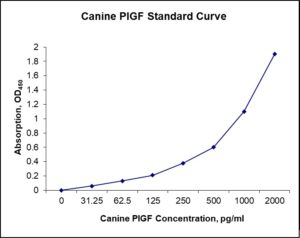Nori Canine PIGF ELISA Kit
$461.00 – $832.00
This ELISA kit is for quantification of PIGF in canine. This is a quick ELISA assay that reduces time to 50% compared to the conventional method, and the entire assay only takes 3 hours. This assay employs the quantitative sandwich enzyme immunoassay technique and uses biotin-streptavidin chemistry to improve the performance of the assays. An antibody specific for PIGF has been pre-coated onto a microplate. Standards and samples are pipetted into the wells and any PIGF present is bound by the immobilized antibody. After washing away any unbound substances, a detection antibody specific for PIGF is added to the wells. Following wash to remove any unbound antibody reagent, a detection reagent is added. After intensive wash a substrate solution is added to the wells and color develops in proportion to the amount of PIGF bound in the initial step. The color development is stopped, and the intensity of the color is measured.
Alternative names for PIGF: PGF, placental growth factor
This product is for laboratory research use only not for diagnostic and therapeutic purposes or any other purposes.
- Description
- How Elisa Works
- Product Citation (0)
- Reviews (0)
Description
Nori Canine PIGF ELISA Kit Summary
Alternative names for PIGF: Placental growth factor, PGF
Alternative names for canine: dog
| Assay Type | Solid Phase Sandwich ELISA |
| Format | 96-well Microplate or 96-Well Strip Microplate |
| Method of Detection | Colorimetric |
| Number of Targets Detected | 1 |
| Target Antigen Accession Number | A0A8C0P0E6 |
| Assay Length | 3 hours |
| Quantitative/Semiquantitative | Quantitative |
| Sample Type | Plasma, Serum, Cell Culture, Urine, Cell/Tissue Lysates, Synovial Fluid, BAL, |
| Recommended Sample Dilution (Plasma/Serum) | No dilution for sample <ULOQ; sufficient dilution for samples >ULOQ |
| Sensitivity | 6 pg/mL |
| Detection Range | 31.25-2000 pg/mL |
| Specificity | Canine PIGF |
| Cross-Reactivity | < 0.5% cross-reactivity observed with available related molecules, < 50% cross-species reactivity observed with species tested. |
| Interference | No significant interference observed with available related molecules |
| Storage/Stability | 4 ºC for up to 6 months |
| Usage | For Laboratory Research Use Only. Not for diagnostic or therapeutic use. |
| Additional Notes | The kit allows for use in multiple experiments. |
Standard Curve
Kit Components
1. Pre-coated 96-well Microplate
2. Biotinylated Detection Antibody
3. Streptavidin-HRP Conjugate
4. Lyophilized Standards
5. TMB One-Step Substrate
6. Stop Solution
7. 20 x PBS
8. Assay Buffer
Other Materials Required but not Provided:
1. Microplate Reader capable of measuring absorption at 450 nm
2. Log-log graph paper or computer and software for ELISA data analysis
3. Precision pipettes (1-1000 µl)
4. Multi-channel pipettes (300 µl)
5. Distilled or deionized water
Protocol Outline
1. Prepare all reagents, samples and standards as instructed in the datasheet.
2. Add 100 µl of Standard or samples to each well and incubate 1 h at RT.
3. Add 100 µl of Working Detection Antibody to each well and incubate 1 h at RT.
4. Add 100 µl of Working Streptavidin-HRP to each well and incubate 20 min at RT.
5. Add 100 µl of Substrate to each well and incubate 5-30 min at RT.
6. Add 50 µl of Stop Solution to each well and read at 450 nm immediately.
Background:
Placental growth factor (PIGF) is a protein that in humans is encoded by the PGF gene.[1][2] Placental growth factor is a member of the VEGF (vascular endothelial growth factor) sub-family – a key molecule in angiogenesis and vasculogenesis, in particular during embryogenesis. The main source of PGF during pregnancy is the placental trophoblast. PGF is also expressed in many other tissues, including the villous trophoblast.[3] Placental growth factor-expression within human atherosclerotic lesions is associated with plaque inflammation and neovascular growth.[4][5] Serum levels of PGF and sFlt-1 (soluble fms-like tyrosine kinase-1, also known as soluble VEGF receptor-1) are altered in women with preeclampsia. Studies show that in both early and late onset preeclampsia, maternal serum levels of sFlt-1 are higher and PGF lower in women presenting with preeclampsia. In addition, placental sFlt-1 levels were significantly increased and PGF decreased in women with preeclampsia as compared to those with uncomplicated pregnancies. This suggests that placental concentrations of sFlt-1 and PGF mirror the maternal serum changes. This is consistent with the view that the placenta is the main source of sFlt-1 and PGF during pregnancy.1
References
- Maglione D, et al. (1993). Oncogene 8 (4): 925–31. PMID7681160.
- Khalil A, et al. (2008). PLoS ONE 3 (7): e2766. doi:1371/journal.pone.0002766.
- Khurana R, et al. (2005). Circulation 111 (21): 2828–2836.
- Shibuya M (2008). BMB Rep 41 (4): 278–86.
Be the first to review “Nori Canine PIGF ELISA Kit”
You must be logged in to post a review.




























Reviews
There are no reviews yet.